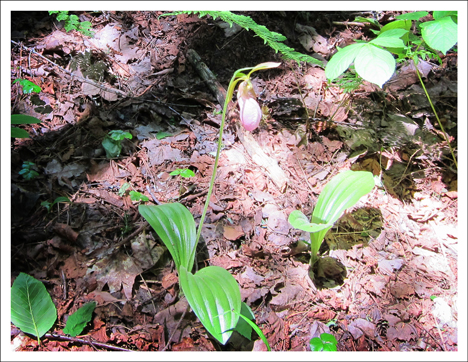Adirondack Wildflowers:
Pink Lady's Slipper
(Cypripedium acaule Aiton)
 Adirondack Wildflowers: Pink Lady's Slipper blooming on the Boreal Life Trail (11 June 2010)
Adirondack Wildflowers: Pink Lady's Slipper blooming on the Boreal Life Trail (11 June 2010)
| This page is no longer being updated. For an updated and expanded version of this material, see: Pink Lady's Slipper (Cypripedium acaule Aiton) |
Pink lady's slipper (also called Moccasin Flower) is a large, showy wildflower belonging to the orchid family. It has two opposite basal leaves with conspicuous parallel veins. A leafless stalk bears 1 flower (rarely 2) with a distinctive pink, inflated, slipper-like lip petal, veined with red and with a fissure down the front. This plant grows 6 to 15 inches tall and flowers generally between May and July. The genus name derives from the Latin for Venus slipper. The species name acaule is Latin, meaning, "stem less", referring to the plant's leafless flowering stem. Another common name for this plant is moccasin flower.
Orchids often have swollen, ball-shaped tubers that were regarded in traditional practices as having medicinal value. The root of lady's slipper was used as a remedy for nervousness, tooth pain, and muscle spasms. In the 1800s and 1900s it, and other orchids, were widely used as a substitute for the European plant valerian for sedative properties.
Pink lady's slipper propagates very poorly and should not be picked. Pink lady's slipper takes many years to go from seed to mature plants. Seed-bearing harvest of wild lady's slipper root is not considered sustainable. Pink lady's slippers can live to be twenty years old or more.
 Adirondack Wildflowers: Pink Lady Slipper blooming at the Paul Smiths VIC (3 June 2011)
Adirondack Wildflowers: Pink Lady Slipper blooming at the Paul Smiths VIC (3 June 2011)
Pink lady's slippers require bees for pollination. Bees are lured into the flower pouch through the front slit, attracted by the flower's bright color and sweet scent. Once inside, the bees find no reward, and discover that they are trapped, with only one point of escape. Inside the pouch, there are hairs that lead to a pair of exit openings, one beneath each pollen mass. The bee must pass under the stigma, so if it bears any pollen from a visit to another flower, it will be deposited before picking up a fresh load on the way out.
Pink lady's slipper lives in a variety of habitats, growing in mixed hardwood coniferous forests of pine and hemlock on rocky/mossy slopes, and in semi-open or in deep humus and acidic but well-drained soil under birch and other deciduous trees of eastern United States forests.
Pink lady's slipper may be seen at the Paul Smiths VIC on the Boreal Life Trail, where it usually blooms in early June.
References
- Lady Bird Johnson Wildflower Center. Native Plant Database.
- United States Department of Agriculture. Plants Database
- US Forest Service. Celebrating Wildflowers
